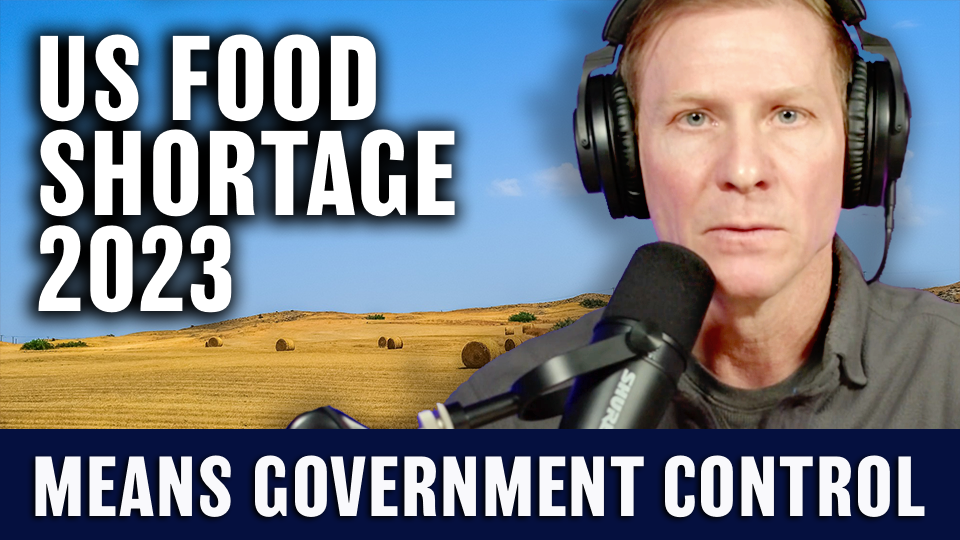HOMELAND ALERT! US Food Shortages Mean Government Control

The decline of U.S. farms has been ongoing for several decades. This is a major concern and potential cause of US food shortages.
There are several factors that contribute to this decline, including:
Consolidation: Many small farms have been forced out of business as larger farms have grown and consolidated their operations. This has been driven by economies of scale and the increasing cost of production.
Urbanization: As more people move into urban areas, farmland is converted into residential or commercial developments, reducing the amount of land available for farming.
Aging farmers: The average age of farmers in the U.S. is increasing, and many older farmers are retiring without younger farmers to take over their operations. This is contributing to a decline in the number of farms.
Economic challenges: Farmers are facing increasing economic pressures, including rising input costs, volatile commodity prices, and competition from imported goods. These challenges make it difficult for many farms to remain profitable.
Environmental concerns: There is growing concern about the impact of farming practices on the environment, including soil erosion, water pollution, and greenhouse gas emissions. This has led to increased regulation and pressure on farmers to adopt more sustainable practices.
Fertilizer shortages can have significant impacts on agriculture, as fertilizers are essential for maintaining soil fertility and supporting plant growth. When fertilizers are in short supply, farmers may face challenges in obtaining the necessary nutrients to support crop growth and yields, which can result in lower crop yields and lower profits, ultimately resulting in less food for the population
Cattle require large amounts of water for drinking and forage production, and if there is not enough water available, it can limit the amount of forage that can be grown and reduce the amount of water available for drinking. Water shortages can also affect the quality of forage available for cattle, as drought conditions can lead to reduced plant growth and lower nutritional content in the plants that do grow. This can make it more difficult for cattle to obtain the nutrients they need to maintain good health and growth rates. In some cases, water shortages can lead to increased competition among farmers and ranchers for limited water resources. This can lead to conflicts and tensions between different user groups, and may even lead to restrictions on water use or allocation.
Reducing stocking rates to ensure that the available water resources can support the remaining cattle population is a necessary practice. Unfortunately, it takes time to rebuild herds. The time can vary depending on several factors, such as the size of the initial herd, the availability of resources, and the management practices employed by the rancher or farmer. In general, it takes several years to rebuild cattle herd numbers. This is because cattle have a relatively long gestation period (approximately nine months) and typically take another year or more to reach breeding age.
Additionally, the rate at which a herd can be rebuilt depends on the number of heifers that are retained for breeding, as well as the fertility and productivity of the cows in the herd. If a rancher or farmer wants to rebuild their herd after a significant decline due to factors such as drought or disease, they may need to take steps to increase their herd's reproductive efficiency, such as implementing a breeding program that emphasizes selection for fertility and productivity traits. They may also need to provide adequate nutrition and care to ensure that the cows are in good condition for breeding. Depending on the specific circumstances, it may take several years or even a decade or more to fully rebuild a cattle herd to pre-decline numbers.
During this time, the rancher or farmer may need to implement careful management practices to ensure that the remaining cattle are productive and healthy, and to prevent further declines in the herd.
Regardless of what we are up against, prepping for a future food shortage just makes sense.
Check out the latest news
Zero risk. Only gains.
100% Risk Free*
Your complete satisfaction guaranteed or your money back.
Made by Real People
Made and packaged in our facility right here in the USA. Any issues, just give us a call.
Free Shipping
Free shipping on orders $199+. Always out the door in a day or two straight to your home.
For more information, please visit our Terms of Service. Lean More









